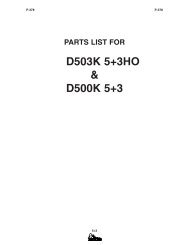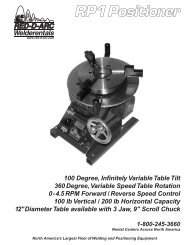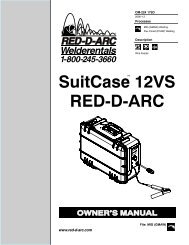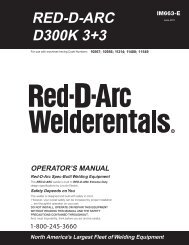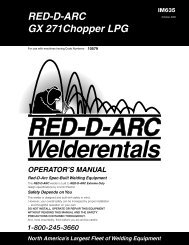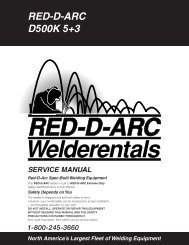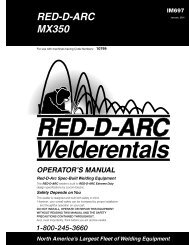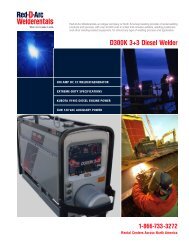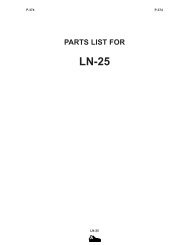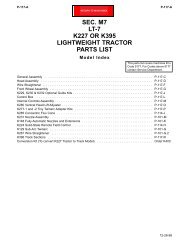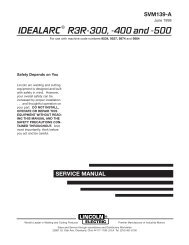RED-D-ARC E500
RED-D-ARC E500
RED-D-ARC E500
Create successful ePaper yourself
Turn your PDF publications into a flip-book with our unique Google optimized e-Paper software.
ii<br />
ELECTRIC SHOCK can kill.<br />
3.a. The electrode and work (or ground) circuits<br />
are electrically “hot” when the welder is on.<br />
Do not touch these “hot” parts with your bare<br />
skin or wet clothing. Wear dry, hole-free<br />
gloves to insulate hands.<br />
SAFETY<br />
<strong>ARC</strong> RAYS can burn.<br />
4.a. Use a shield with the proper filter and cover<br />
plates to protect your eyes from sparks and<br />
the rays of the arc when welding or observing<br />
open arc welding. Headshield and filter lens<br />
should conform to ANSI Z87. I standards.<br />
ii<br />
3.b. Insulate yourself from work and ground using dry insulation.<br />
Make certain the insulation is large enough to cover your full<br />
area of physical contact with work and ground.<br />
In addition to the normal safety precautions, if welding<br />
must be performed under electrically hazardous<br />
conditions (in damp locations or while wearing wet<br />
clothing; on metal structures such as floors, gratings or<br />
scaffolds; when in cramped positions such as sitting,<br />
kneeling or lying, if there is a high risk of unavoidable or<br />
accidental contact with the workpiece or ground) use<br />
the following equipment:<br />
• Semiautomatic DC Constant Voltage (Wire) Welder.<br />
• DC Manual (Stick) Welder.<br />
• AC Welder with Reduced Voltage Control.<br />
3.c. In semiautomatic or automatic wire welding, the electrode,<br />
electrode reel, welding head, nozzle or semiautomatic<br />
welding gun are also electrically “hot”.<br />
3.d. Always be sure the work cable makes a good electrical<br />
connection with the metal being welded. The connection<br />
should be as close as possible to the area being welded.<br />
3.e. Ground the work or metal to be welded to a good electrical<br />
(earth) ground.<br />
3.f.<br />
Maintain the electrode holder, work clamp, welding cable and<br />
welding machine in good, safe operating condition. Replace<br />
damaged insulation.<br />
3.g. Never dip the electrode in water for cooling.<br />
3.h. Never simultaneously touch electrically “hot” parts of<br />
electrode holders connected to two welders because voltage<br />
between the two can be the total of the open circuit voltage<br />
of both welders.<br />
3.i.<br />
When working above floor level, use a safety belt to protect<br />
yourself from a fall should you get a shock.<br />
3.j. Also see Items 6.c. and 8.<br />
4.b. Use suitable clothing made from durable flame-resistant<br />
material to protect your skin and that of your helpers from<br />
the arc rays.<br />
4.c. Protect other nearby personnel with suitable, non-flammable<br />
screening and/or warn them not to watch the arc nor expose<br />
themselves to the arc rays or to hot spatter or metal.<br />
FUMES AND GASES<br />
can be dangerous.<br />
5.a. Welding may produce fumes and gases<br />
hazardous to health. Avoid breathing these<br />
fumes and gases.When welding, keep<br />
your head out of the fume. Use enough<br />
ventilation and/or exhaust at the arc to keep<br />
fumes and gases away from the breathing zone. When<br />
welding with electrodes which require special<br />
ventilation such as stainless or hard facing (see<br />
instructions on container or MSDS) or on lead or<br />
cadmium plated steel and other metals or coatings<br />
which produce highly toxic fumes, keep exposure as<br />
low as possible and below Threshold Limit Values (TLV)<br />
using local exhaust or mechanical ventilation. In<br />
confined spaces or in some circumstances, outdoors, a<br />
respirator may be required. Additional precautions are<br />
also required when welding on galvanized steel.<br />
5.b. Do not weld in locations near chlorinated hydrocarbon vapors<br />
coming from degreasing, cleaning or spraying operations.<br />
The heat and rays of the arc can react with solvent vapors to<br />
form phosgene, a highly toxic gas, and other irritating<br />
products.<br />
5.c. Shielding gases used for arc welding can displace air and<br />
cause injury or death. Always use enough ventilation,<br />
especially in confined areas, to insure breathing air is safe.<br />
5.d. Read and understand the manufacturer’s instructions for this<br />
equipment and the consumables to be used, including the<br />
material safety data sheet (MSDS) and follow your<br />
employer’s safety practices. MSDS forms are available from<br />
your welding distributor or from the manufacturer.<br />
5.e. Also see item 1.b.<br />
Mar ‘95<br />
<strong>E500</strong>





